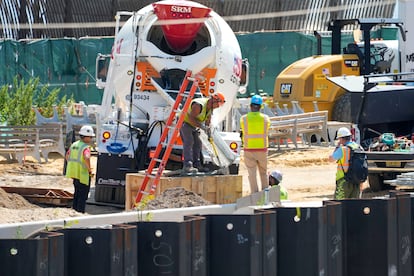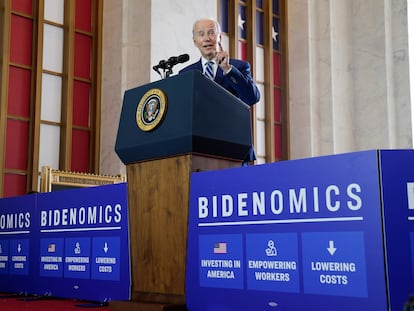US slowed hiring but still added a solid 209,000 jobs in June in sign of economy’s resilience
The wage data may raise concerns at the Fed, which is worried that faster pay gains will perpetuate inflation by leading companies to raise prices to offset their higher labor costs

The world’s largest economy has been creating jobs every month for two and a half years. In those two and a half years, more than 13 million jobs have been created, record numbers. In June, 209,000 were added to the total, according to data released this Friday by the Bureau of Labor Statistics. The unemployment rate fell from 3.7% to 3.6%, near a five-decade low.
Job creation is lower than in May, but remains very robust. Economists expected 230,000 jobs and an unemployment rate of 3.6%, according to data compiled by Bloomberg.
Most of the details in the report underscored the job market’s durability. The length of the average work week edged up, a sign that customer demand is strong enough to keep employees busy. And wage growth accelerated: Hourly pay is up 4.4% from a year ago. Wages are now growing faster than year-over-year inflation, which amounted to 4% in May.
The wage data may raise concerns at the Fed, which is worried that faster pay gains will perpetuate inflation by leading companies to raise prices to offset their higher labor costs. The Fed wants to see hiring and wage increases slow before halting its rate hikes.
“This is kind of a Goldilocks report,” said Julia Coronado, president of MacroPolicy Perspectives, an economic research firm. “It’s a resilient labor market — not too hot, not too cool.”
Friday’s data contained some evidence of a slower pace of hiring, which could reassure the Fed that the economy is moderating. Most of the job growth came from state and local governments, health care companies and private education, which together added 133,000 jobs. Because those sectors don’t depend on robust consumer spending as much as the rest of the economy does, their hiring gains don’t really reflect rising consumer demand — the main fuel for inflation.
Dean Baker, senior economist at the Center for Economic Policy Research, noted that excluding government hiring, private-sector job gains totaled 149,000 in June, a pace that does not point to an overheating economy that might alarm the Fed.
“It’s hard to say that’s too fast,” Baker said. “That’s pretty much sustainable.”
The government on Friday also downgraded its estimate of job growth for April and May combined by a substantial 110,000, another sign that hiring has eased from last year’s breakneck pace.
The economy has been beset by high interest rates, elevated inflation and nagging worries about a possible recession resulting from the Fed’s ever-higher interest rates. Even so, many industries keep adding jobs to keep up with consumer spending and restore their workforces to pre-pandemic levels.
The solid pace of hiring and rising wages have enabled consumers to keep spending on services, from traveling to dining out to attending entertainment events. While economists have repeatedly forecast a recession for later this year or next year, a downturn is unlikely as long as companies keep steadily filling jobs.
The Fed has jacked up its key interest rate by a sizable 5 percentage points — the fastest pace of rate hikes in four decades. Those increases have made mortgages, auto loans and other forms of borrowing significantly more expensive.
Some Fed officials have said they are looking for signs of what they describe as better balance in the job market, by which they mean the supply and demand for workers would become more equal. After the economy emerged from the pandemic, the number of available jobs surged above 10 million — the highest level on record.
The burgeoning demand for labor coincided with millions of Americans dropping out of the workforce to retire, avoid COVID, care for relatives or prepare for new careers. With companies struggling to fill openings, many offered sharply higher pay and better benefits to attract or keep employees.
There has been some progress toward a better alignment of supply and demand: More people have started looking for work in recent months, and most of them have found jobs. As the supply of workers has improved, businesses have said they’re seeing more people apply for open positions. The number of job openings dropped in May, a sign that demand for workers is gradually cooling, though it remains above pre-pandemic levels.
In a sign of a potential slowdown in the job market, fewer Americans are quitting their jobs to seek new positions. Quits had soared after the pandemic. Millions of Americans had sought more meaningful or better-paying jobs, stoking the pressure on companies to raise pay to keep their employees. In May, about 4 million Americans left their jobs, up from April’s figure but below a peak of 4.5 million reached last year.
Still, other recent reports suggest that the economy has continued to expand and that demand for workers remains high. On Thursday, a survey of service providers — including banks, restaurants and shipping companies — found that the sector expanded at a healthy clip in June and that services companies accelerated their hiring compared with May.
Follow all the information on Economy and Business on Facebook and Twitter, or in our weekly newsletter
Tu suscripción se está usando en otro dispositivo
¿Quieres añadir otro usuario a tu suscripción?
Si continúas leyendo en este dispositivo, no se podrá leer en el otro.
FlechaTu suscripción se está usando en otro dispositivo y solo puedes acceder a EL PAÍS desde un dispositivo a la vez.
Si quieres compartir tu cuenta, cambia tu suscripción a la modalidad Premium, así podrás añadir otro usuario. Cada uno accederá con su propia cuenta de email, lo que os permitirá personalizar vuestra experiencia en EL PAÍS.
¿Tienes una suscripción de empresa? Accede aquí para contratar más cuentas.
En el caso de no saber quién está usando tu cuenta, te recomendamos cambiar tu contraseña aquí.
Si decides continuar compartiendo tu cuenta, este mensaje se mostrará en tu dispositivo y en el de la otra persona que está usando tu cuenta de forma indefinida, afectando a tu experiencia de lectura. Puedes consultar aquí los términos y condiciones de la suscripción digital.
More information
Archived In
Últimas noticias
Welcome to the post-religion era: The idea of Christianity as the absolute truth has become obsolete
‘I thought you would like it’: The risky sexual practice popularized by TV shows and TikTok
The digitalization of tourism: ‘They promise experiences and gave us the worst possible one’
Mexican peso defies uncertainty with forecasts of a new period of stability in 2026
Most viewed
- Sinaloa Cartel war is taking its toll on Los Chapitos
- Reinhard Genzel, Nobel laureate in physics: ‘One-minute videos will never give you the truth’
- Oona Chaplin: ‘I told James Cameron that I was living in a treehouse and starting a permaculture project with a friend’
- Why the price of coffee has skyrocketed: from Brazilian plantations to specialty coffee houses
- Silver prices are going crazy: This is what’s fueling the rally









































